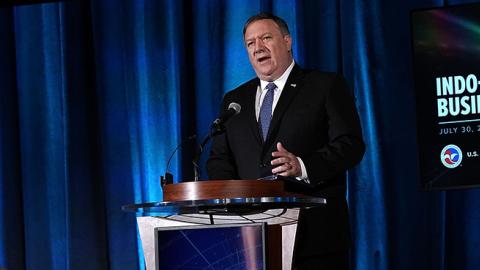p(firstLetter). American grand strategy has always aimed at suppressing security competitions and the rise of a rival hegemon. The not-so-peaceful economic and military rise of China and its ambition to craft a new maritime and continental order in Asia thus pose a challenge to seven decades of American preeminence in the region—a reality that the Trump Administration acknowledged in its first National Security Strategy. In response, the Administration has often touted its “Indo-Pacific” strategy, which in practice seeks to counter China by building a network of allies and partners to contain and push back against Chinese revisionism.
U.S. Secretary of State Mike Pompeo’s speech at the Indo-Pacific Business Forum on July 30 sought to outline the U.S. strategy in the months ahead. Secretary Pompeo’s speech was akin to one made by former Secretary of State Rex Tillerson last year. This past October, Tillerson sought to lay out the contours of U.S. India policy; ten months later, his successor seeks to fill in the blanks on the wider Indo-Pacific strategy.
For some months now allies across Asia have voiced concerns about whether the United States is a reliable partner or whether it would withdraw from the region. A number of countries—including Australia, India, South Korea and several ASEAN members—have thus sought a hedging strategy with respect to China. Secretary of Defense James Mattis’s speech at the Shangri-La Dialogue in June was aimed at reassuring the region, with Pompeo’s speech as the follow-on. Secretary Mattis stated that the Indo-Pacific strategy was a subset of the broader American grand strategy for “stability, security, and prosperity” around the globe. Mattis also asserted that what underlined this strategy were “shared principles,” a “commitment to common values,” and a “shared destiny.”
One of the challenges facing the Indo-Pacific strategy has been that every country in the region has interpreted it differently. While everyone agrees with the “free” and “open” language, different countries have chosen to emphasize different parts of the Indo-Pacific concept.
Japan views it as a strategy to counter China. During a speech that Prime Minister Shinzo Abe delivered before the Indian parliament in 2007, he spoke about the confluence of the Indian Ocean and the Pacific Ocean. Five years later during his swearing in as Prime Minister, Abe spoke about Asia’s Democratic Security Diamond, emphasizing the need for India, the United States, Australia, and Japan to cooperate for “peace, stability and freedom of navigation” in both the Oceans.
Prime Minister Narendra Modi laid out India’s definition of the Indo-Pacific during his June 2018 speech at Shangri-La, where he explained both how India viewed the idea geographically—a space extending “from the shores of Africa to that of the Americas”—and conceptually, in terms of “inclusiveness, openness and ASEAN centrality.” In their recent speeches both the U.S. and Indian leadership have emphasized that the ASEAN countries are central to the Indo-Pacific vision. That Secretary Pompeo is delivering a speech at the ASEAN security meeting in Singapore today underscores this point.
But doubts still linger, both within the United States and in Asian capitals, about whether the U.S. Indo-Pacific strategy simply comprises stray speeches by key officials. While Secretary Pompeo’s speech did not flesh out a full-fledged strategy, it did send a few key signals.
First, Pompeo stressed that the Indo-Pacific remains critical to American interests and that the United States is in the region to stay. Echoing Secretary Mattis, Pompeo reiterated American support for a regional order of “independent nations” without “domination” by any one country and emphasized U.S. “commitment” to helping its partners and allies build their economies and their security. While the top American diplomat emphasized that the Indo-Pacific strategy did not exclude any country, the message was not lost on Beijing.
Pompeo also addressed queries about whether or not the United States was willing to invest economically in the region in order to counter China’s Belt and Road Initiative (BRI). At a time of economic protectionism, when the Trump Administration’s policy is to invest more money at home and ask American companies to do likewise, it is not politically feasible for the U.S. government to invest significantly more money abroad and compete dollar for dollar with China.
What Secretary Pompeo offered instead in his recent speech was a framework and a variety of existing mechanisms—including the Millennium Challenge Corporation (MCC) and the Overseas Private Investment Corporation (OPIC)—through which the U.S. government would provide targeted assistance to countries in the region with the expectation that those countries would then use that aid to build their capacities. He also touted the BUILD Act, a development-finance bill currently under consideration in the Senate, and announced a $113 million investment to boost digital connectivity, cyber security, energy, and infrastructure.
The United States will also look to its partners and allies across the region to augment American efforts in the region. In 2017 India and Japan announced the Asia-Africa Growth corridor with over $200 billion in proposed projects across the region. In April 2018, the United States, India and Japan announced collaboration in the field of infrastructure in Nepal, Myanmar and Bangladesh.
In June 2018, Prime Minister Abe committed $50 billion for infrastructure projects across Asia. With China encroaching on Australia’s backyard in the South Pacific, Australia’s commitment to the Indo-Pacific has deepened in the past few months. Just two days after Pompeo’s speech, both Australia and Japan announced a trilateral partnership with the United States for infrastructure in the region.
Secretary Pompeo’s speech sent many of the right messages, but we still lack a clearly defined Indo-Pacific strategy. Fundamental issues still need to be resolved, starting with the geographical disconnect. While India would like the Indo-Pacific to include the western Indian Ocean (the Arabian Sea and the east coast of Africa), the United States and most others have—as of now—limited the Indo-Pacific to the western shores of India or the mandate of the INDOPACOM.
Further, the United States is not investing nearly as much money as China is offering and Japan’s billions, while necessary, are not sufficient to compete either. What is required is the elaboration of a detailed counter-strategy to China’s Belt and Road so that the world, including China, understands what “our” Belt and “our” Road is.


















